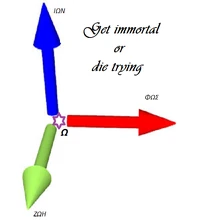Φοινίκη
Phoenicia, Phoenice
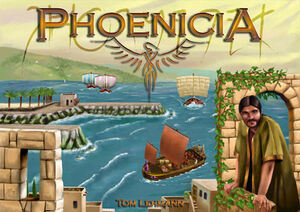
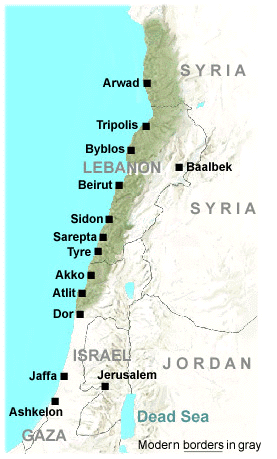
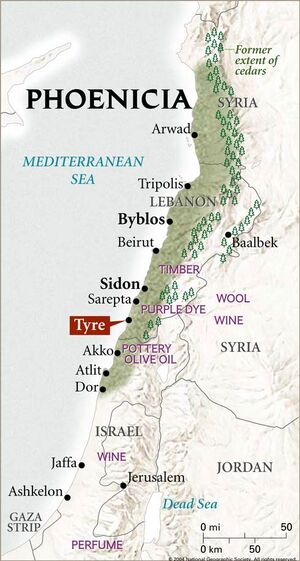


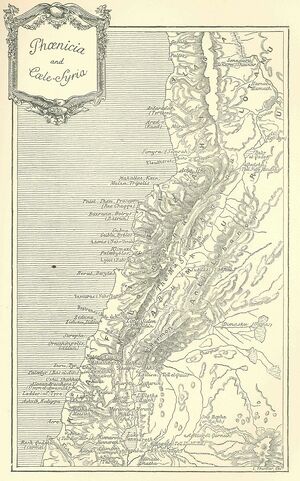
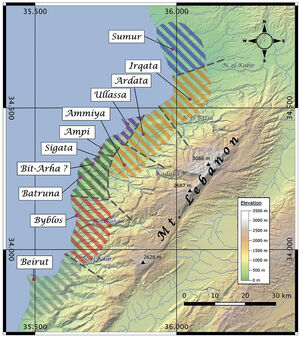
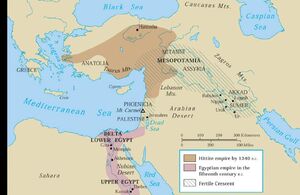
Αιγυπτιακή Αυτοκρατορία
Ασσυρία
Χετταϊκή Αυτοκρατορία
Βαβυλωνία
- Μία ιστορική χώρα της Δυτικής Ασίας.
Ετυμολογία[]
| Ιστορικές Πόλεις
|
|---|
| Βόρεια Φοινίκη |
|
| Κεντρική Φοινίκη |
|
|
| Νότια Φοινίκη |
|
Η ονομασία "Φοινίκη" σχετίζεται ετυμολογικά με την λέξη "Πνύκα".
Αναφέρεται το αρχαιότερο όνομά της, από Ελληνική πηγή, ως Χνα (= Χαναάν)
Εισαγωγή[]
Οι κάτοικοί της αποκαλούνταν Φοίνικες από τους Έλληνες.
Η Φοινίκη, η χώρα των Φοινίκων ήταν μια στενή λωρίδα στην ανατολική λεκάνη της Μεσογείου. Ανατολικά συνόρευε με τα όρη του Λιβάνου, και νοτιοανατολικά με τους λόφους της Γαλιλαίας.
Το όνομά της Φοινίκη, είναι απόδοση στα ελληνικά του ονόματος Χαναάν, αλλά δηλώνει το βόρειο παραλιακό τμήμα της χώρας.
Οι Φοίνικες σύμφωνα με τον Ηρόδοτο ήλθαν από τα παράλια της λεγόμενης "Ερυθράς Θάλασσας" (δηλ. Περσικός Κόλπος) και εγκαταστάθηκαν στη Φοινίκη.
Δημογραφία[]
Οι σημαντικότερες ιστορικές Πόλεις ήταν:
Τύρος, Σιδών, Βύβλος , Άραδος και Βηρυτός ήταν διάσημες εμπορικές πόλεις.
Με την σειρά: Λαοδίκεια, Γάβαλα, Βαλανέα, Πάλτος, Άραδος (with its dependency Antaradus), Μάραθος, Σίμυρα, Ορθωσία, Άρκα, Τρίπολις, Κάλαμος, Τριήρης, Βότρυς, Βύβλος (Byblus or Gebal); Aphaca), Βηρυττός, Σιδώνα, Sarepta,Ορνιθόπολις, Τύρος, Έκδιππα, Άκκη, Πορφυρόπολη (Πορφυρών), Δώρα, Ιόππη
Επίσης:
- Βουκολόπολις
- Κροκοδειλόπολις
- Συκαμινόπολη (Συκάμινος)
- Στρατωνίδα (Πύργος Στράτωνος)
- Λεοντόπολις
- Θεοπροσωπίτις
- Κάρνος
- Ένυδρα
- Παλαίτυρος
- Αντάραδος
- Ηλιόπολις (Baalbeck)
Ιστορία[]
Χρονολόγιο[]
- B.C.2750 Founding of Tyre, according to Herodotus.
- B.C.2000 (circa) Taaut or Thoth the first Hermes invented the alphabet.
- B.C.1700 (circa) Cadmus introduced the alphabet to the Greeks.
- B.C.1590 The Phoenician Canaanites are spoken of as battling against the Egyptians.
- B.C.1500 (circa) The Phoenicians settle Cyprus.
- B.C.1300 They make commercial treaties with Egypt.
- B.C.1260 (circa) Sanchuniathon Phoenician priest and writer became known in the ancient world.
- B.C.1250 (circa) Posidonius the Stoic name Mochus of Sidon, as the originator of the atomic theory.
- B.C.1252 War of Sidon against the Philistines, and possible devastation of Sidon.
- B.C.1200 Tyre becomes the chief Phoenician city at the time when the Trojan wars begin.
- B.C.1100 Cadiz and other colonies planted on the Atlantic shores.
- B.C.1020 Abibal, the earliest known king of Tyre.
- B.C.980 Hiram succeeded Abibal, formed alliance with kings David and Solomon, built up Tyre, and sent out rich trading expeditions.
- B.C.990 (circa) Zadok the Priest, pagan Phoenician priest and king of Jerusalem anointed Solomon king.
- B.C.970 (circa) Hiram, king of Tyre, builds the Temple of Solomon
- B.C.887 Eth-baal, the priest king, seizes the throne
- B.C.876 Phoenician cities pay tribute to Assyria.
- B.C.860 (circa) Jezebel, princess of Tyre, married Ahab, king of Israel.
- B.C.854 Phoenicians defeated by the Assyrians.
- B.C.813 Carthage founded.
- B.C.727 Luliya of Tyre asserts his independence and Phoenicia is ravaged by the Assyrians.
- B.C.725 Tyre wins against the Assyrians the first naval battle of history, and withstands a five years' siege.
- B.C.701 Luli, king of Sidon, abandoned his city to Sennacherib of Assyria and escaped to Cyprus where he perished
- B.C.695 Spain becomes an independent Phoenician kingdom.
- B.C.678 Sidon besieged for three years and captured by the Assyrians.
- B.C.636 Phoenician cities escape from the weakened Assyrian empire.
- B.C.600 Phoenician Thales of Miletus became known as the first known philosopher, scientist and mathematician.
- B.C.587 Nebuchadnezzar begins his great thirteen year siege of Tyre. The city finally capitulates.
- B.C.585 Phoenician Thales of Citium forecasted the solar eclipse of that year.
- B.C.570 (circa) Pythagoras, Phoenician mathematician and scientist was trained in the mysteries of Phoenician religion in the temples of Phoenicia.
- B.C.538 Phoenicia becomes a Persian province; Carthage asserts its independence.
- B.C.536 The Carthaginians drive the Greeks from Corsica.
- B.C.509 Carthage acknowledged by Rome as ruler of the western seas.
- B.C.500 (circa) Hanno circumnavigates Africa.
- B.C.510 (circa) Himilco, Carthaginian voyager, the first known sailor from the Mediterranean to have reached the northwestern shores of Europe.
- B.C.440 (circa) Herodotus, the Greek historian, visited and wrote about Phoenicia.
- B.C.480 The Phoenician ships under Persian rule defeated by the Greeks at Salamis and the Carthaginians defeated at Himera.
- B.C.397 An African revolt against Carthage suppressed.
- B.C.332 Tyre besieged by Alexander the Great and stormed after a remarkable contest.
- B.C.310 Carthage besieged by the Greeks of Sicily.
- B.C.306 (circa) Zeno of Citium, Stoic philosopher, became well known for his work.
- B.C.276 Carthage finally conquers Sicily.
- B.C.264 Carthage begins her first war with the Romans and beginning of Punic wars.
- B.C.260 The Carthaginian fleet was defeated at Mylae.
- B.C.256 The Carthaginian fleeet was defeated a second time at Ecnomus; the Romans invade Africa, but are defeated and their army perishes.
- B.C.248 Hamilcar repeatedly defeats the Romans in small battles in Sicily.
- B.C.241 Carthage sues for peace; terrible war of her mercenary soldiers against Carthage.
- B.C.237 Hamilcar crushes the mercenaries.
- B.C.236 Hamilcar begins the building of an empire among the Phoenician cities in Spain.
- B.C.228 Hasdrubal succeeds Hamilcar and continues his work in Spain.
- B.C.219 Hannibal succeeds Hasdrubal and defies the Romans.
- B.C.218 Hannibal crosses the Alps into Italy and wins repeated victories.
- B.C.216 Hannibal's chief victory at Cannae; the Romans no longer dare meet him in the field.
- B.C.211 Hannibal besieges Rome, but abandons the siege as hopeless.
- B.C.209 The Romans victorious in Spain.
- B.C.207 A second Carthaginian army, having crossed the Alps, is defeated at the Metaurus.
- B.C.204 The Romans invade Africa.
- B.C.203 Hannibal recalled to defend Carthage.
- B.C.202 He is defeated at Zama.
- B.C.201 Carthage submits to Rome.
- B.C.198 Tyre came under the rule of the Seleucids.
- B.C.183 Death of Hannibal.
- B.C.149 The Carthaginians commanded to leave their city; they resist and withstand a two years' siege.
- B.C.146 Fall of Carthage and end of Punic wars.
- B.C.130 Zeno of Sidon, the philosopher, wrote on logic, atomic theory, biology, ethics, literary style, oratory, poetry, the theory of knowledge, and to mathematics as well as commentary on the philosopher Epicurus.
- B.C.126 Tyre obtaining self-government from Seleucids.
- B.C.29 A Roman colony rebuilds Carthage under Augustus Caesar; and it becomes a great city.
- A.D.27 (circa) Jesus Christ visited Sidon
- A.D.35 (circa) Saint Peter, Paul and other Apostles visited and consecrated Phoenician bishops
- A.D.40 (circa) John Mark designated Bishop of Byblos by St. Peter
- A.D.45 (circa) Joseph of Arimathea traveled to Britain.
- A.D.100 Philo of Byblos, Writer, became known for his literary achievements especially the translation of the work of Sanchuniathon the Priest.
- A.D.140 Papinian, jurist at the famous Berytus School of Law and author of several important works was born.
- A.D.155 Phoenician Anicitus became Pope.
- A.D.172 Ulpian of Tyre, Roman jurist, coming from a family of scholars was born.
- A.D.203 Sts. Perpetua and Felicity, Christian martyrs, of Carthage meet their death.
- A.D.237 Barbara of Heliopolis, Christian martyr, meet her death
- A.D.250 Porphyry Malchus of Tyre, the mathematician and disciple of Plotinus, revised and edited of the latter's works.
- A.D.253 Origen died there in Tyre as a consequence of the tortures which he underwent under Decius, and was buried in the church magnificent cathedral.
- A.D.293 Theodosia of Tyre and Aquilina of Byblos, Christian martyrs, meet their deaths
- A.D.300 Christina of Tyre, Christian martyr, meet her death
- A.D.306 St. Ulpianus of Tyre met his martyrdom when he was thrown into the sea.
- A.D.307 St. Theodosia, a young Tyrian girl of eighteen, met her martyrdom when she was horribly tortured and then thrown into the sea on Easter Sunday, 2 April.
- A.D.309 Phoenician St. Pamphilus of Cæsarea Martyred
- A.D.311 A municipal decree was issued forbidding Christians to stay in the city of Tyre.
- A.D.328 Phoenician St. Frumentius became Apostle of Abyssinia and Bishop of Axum, Ethiopia.
- A.D.335 The first council of Tyre, convened by Constantine, judged the cause of St. Athanasius, and deposed him.
- A.D.400? Saint Jerome visits Tyre when it became the capital of Phoenicia and was the richest and greatest commercial city of the province. Its factory of purple cloth was foremost in the empire.
- A.D.425 Phoenicia Prima was subdivided into two provinces, Phoenicia Maritima and Phoenicia Libanensis
- A.D.449 The second council of Tyre examined the cause of Ibas, Bishop of Edessa, who was accused by the clerics of his church and absolved by this council.
- A.D.515 The third council of Tyre 515 under the presidency of Severus, Patriarch of Antioch, and rejected the Council of Chalcedon.
- A.D.534 Dorotheus, professors of law at the famous Berytus School of Law, with Tribonian and Theophilus (advocates) publish the new Codex of imperial constitutions as ordered by Emperor Justinian.
- A.D.613 The Jews of Tyre formed a vast conspiracy against the Byzantines Empire.
- A.D.638 Tyre fell into the hands of the Arabs.
- A.D.685 Phoenician John V became Pope.
- A.D.687 Phoenician St. Sergius became Pope.
- A.D.697 Carthage was destroyed by the Arabs.
- A.D.708 Phoenician Sisinius became Pope.
- A.D.708 Phoenician Constantine I became Pope.
- A.D.731 Phoenician Gregorius III became Pope.
- A.D.1112 Tyre fell to the Christian crusader King Baldwin I, King of Jerusalem.
- A.D.1124 Second Christian siege of Tyre; it was captured.
- A.D.1187 The Christians in Tyre withstood a two years' siege by the Arabs; but Acre was made the chief port of the Christian kingdom and all the old Phoenician cities decline.
- A.D.1210 John of Brienne was crowned king, and in 1225 his daughter Isabella was crowned queen in Tyre.
- A.D.1291 Tyre fell to the Arabs who completely destroyed it, and it was never wholly restored afterwards.
- A.D.1516 Phoenicia was captured by the Turks and its cities decay utterly.
Υποσημειώσεις[]
Εσωτερική Αρθρογραφία[]
Βιβλιογραφία[]
Ιστογραφία[]
|
Αν και θα βρείτε εξακριβωμένες πληροφορίες "Οι πληροφορίες αυτές μπορεί πρόσφατα Πρέπει να λάβετε υπ' όψη ότι Επίσης, |
- Μην κάνετε χρήση του περιεχομένου της παρούσας εγκυκλοπαίδειας
αν διαφωνείτε με όσα αναγράφονται σε αυτήν
- Όχι, στις διαφημίσεις που περιέχουν απαράδεκτο περιεχόμενο (άσεμνες εικόνες, ροζ αγγελίες κλπ.)
